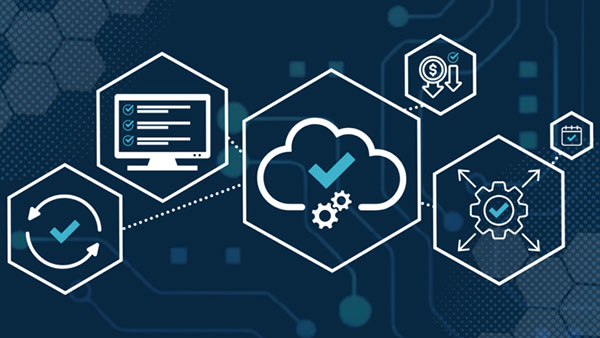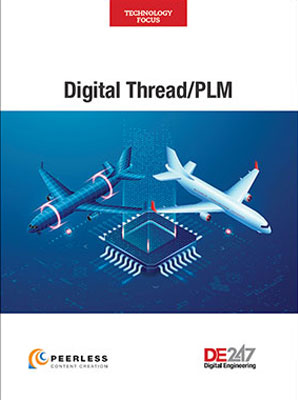How to Move Your PLM Processes to the Cloud
Shifting to a cloud-based PLM approach requires asking some tough questions.

Fig. 1: Cloud-based PLM systems promise to provide easy, unrestricted access to the complete spectrum product data, spanning the digital thread. This streamlines and extends collaboration and supports remote workforces. Image courtesy of Siemens Digital Industries Software.
May 8, 2023
Today’s workforce and workflows have undergone tremendous changes, and that process has transformed the dimensions of time and space within which products are developed. Current market conditions do not allow companies to do business as usual—if they want to prosper. For many companies, this means that they must move their product lifecycle management (PLM) processes to the cloud.
But making the transition from on-premises systems to cloud-based platforms is not as simple as flipping a switch. Companies contemplating this move must carefully consider the questions that have long confronted companies embarking on major software implementations. They’ll have to answer questions like: what features should we look for? What is the best way to find the right software provider? Should we do the implementation ourselves or turn to a systems integrator?
Answering these questions correctly promises to greatly improve the odds for success and lay a foundation for a future-proof environment tailored for easier, faster and more streamlined collaboration among all stakeholders on a global scale. Answering the questions incorrectly may set the stage for the company’s obsolescence.
Confronting PLM’s New Realities
In the past, cloud PLM system adoption lagged behind other cloud-based software platforms such as customer relationship management (CRM), but in recent years, the market has seen more companies moving from on-premises PLM systems to cloud-based platforms. A few key factors seem to be adding momentum to this trend. One standout factor is the recent pandemic.
“COVID seemed to jumpstart the transition to cloud-based PLM, driving companies to seek collaborative solutions available anytime and anywhere to employees working remotely,” says George Lewis, vice president of strategic business development at Arena, a PTC business.
This reaction stems from the growing geographic distribution of the workforce and the increasing demands being made on supply chains (Fig. 1).
“COVID changed how we work,” says Eric Schrader, chief product officer at Propel Software. “Our new, distributed workforce turned homes into offices for many of today’s workers. Overnight, everyone had to figure out how to do their job with new working parameters. On-premises PLM became an inhibitor to that process and the cloud became an enabler.”
The growing reliance on supply chain partners to meet increasingly dynamic market demands also triggered a sense of urgency and immediacy in companies’ deliberations to shift PLM processes to the cloud. Simply operating on-premises PLM no longer seems to be enough in an era of digital transformation.
“Current globalization, environmental and competitive scenarios demand the involvement of the suppliers during the product development cycles,” says Ana Friedlander, industry and solution strategy director for fashion retail at Infor. “The limitations of an on-premises PLM solution do not allow this flexibility, while cloud PLM is mobile and accessible from anywhere.”
This accessibility opens the door to collaboration among designers, customers and suppliers of the value chain through a common platform. The increased accessibility also works well with remote working. With cloud accessibility, internal staff and suppliers can get the data that they require directly from their browsers.
“Being able to access data from a browser means it can be accessed from anywhere,” says Schrader. “Support for remote work is an essential benefit. About 75 percent of the value of a product is in the supply chain, and many interactions with the supply chain are adjacent to the concept of remote work. Cloud-based PLMs can help incorporate suppliers and contract manufacturers into these processes to streamline and limit/remove data transfer challenges.”
Other dynamic elements of the market further highlight the need for PLM accessibility and flexibility.
“Events like company mergers and acquisitions, shifting business partners, new collaborative processes and changing supply chains affect how PLM environments are designed,” says Bruce Bookbinder, product marketing manager at Aras. “As system functionality changes, the volume of information being stored or accessed within the system will likely increase significantly. Reacting to these shifts means you must have the proper infrastructure available, in place and correctly configured, to maintain acceptable response times. This requires the elasticity of the cloud.”
A Good Value Proposition
In addition to enhanced accessibility and flexibility, cloud PLM offers numerous advantages that address bottom-line concerns.
In terms of performance, cloud systems are typically built on the latest technologies and architectures, which ensures that companies have access to the most up-to-date features and functions. Furthermore, cloud-based systems are more agile than on-premises systems.
“Cloud-based PLM systems are highly scalable, making it easier for companies to add or remove users, storage and other resources as needed,” says Bookbinder. “This can help companies quickly respond to changing business needs.”
These systems also have more streamlined maintenance because the cloud service provider is responsible to maintain and update the infrastructure.
“We know technological developments and increasing requirements don’t stop,” says Friedlander. “Having a PLM on the cloud eliminates the pain of constantly updating any on-premises PLM systems. Not only are there upgrade costs, but there may also be hardware and server upgrades that may be required. The subscription to cloud PLM solutions means that all updates and new functionality releases are ongoing, so the subscribers have the advantage of always having the latest features, and easily comply with the ever-changing industry requirements.”
Furthermore, the overall cost of cloud-based PLM systems promises to be lower than its on-premises competition.
“In terms of cost benefits, the first thought is that there are zero infrastructure costs with PLM on the cloud,” says Friedlander. “The cost of hardware maintenance and in-house technical support expertise can be eliminated. A company will never have to worry about another upgrade expense, which can be very costly and painful. Cloud-based PLMs also have releases that are now available as features and are included in the cost of the subscription.”
Security Becomes Less of a Concern
Security also plays a role in winning the hearts and wallets of companies contemplating moving their product intellectual property to the cloud, but it’s now cast in a new light.
“This security reservation is becoming less of a factor because the cloud has proven to be more secure than on-premises, and secure platforms—specifically for aerospace and defense companies—are available,” says Arena’s Lewis.
In fact, many organizations contend that with the cloud they can get the same or better security as that provided by on-premises environments at much less cost.
“Cloud-based PLM solutions often have stronger security features and are more resistant to cyberattacks than on-premises solutions,” says Bookbinder. “With an excellent economy of scale, cloud providers guarantee the latest technology, and the best-trained security professionals are protecting customers’ data and preventing cyberattacks.”
Fear of Disruption and Incompatibilities
Although companies have recognized the significant value of moving their PLM processes to the cloud, the actual migration can be very complex and daunting.
PLM systems handle a substantial amount of data from globally distributed users and often integrate with multiple systems to create their products’ digital threads. The thought of substantially disrupting existing critical systems and potentially creating incompatibilities among connected processes often weighs heavily on decision-making, slowing or even stopping technology adoption.
To make matters even more challenging, cloud PLM proponents contend that such a transition is not complete unless the company also uses the transition to rethink and streamline its key processes and business models (Fig. 2).

“The challenge that exists for companies is to go beyond merely considering the platform or technology aspects of this move,” says Schrader. “Businesses must also rethink their processes at the same time so that they can future-proof their business models. Companies have a tendency to reproduce current processes without thinking about how that might be holding them back from taking advantage of the capabilities of the cloud or achieving greater agility. Forward-looking organizations need to look at this as an opportunity to simplify and modernize. They should examine what is needed to support their business today and approach the adaptation as a digital transformation.”
How to Choose the Right Vendor
Companies can best position themselves for a successful transition to a cloud-based platform by working with the right vendor. To do this, companies must research the vendors under consideration, making sure that they have a seasoned implementation and a solid customer support team in place, a record of standing behind their software, and clear direction for cloud. This will help to ensure that companies follow best practices that meet their specific requirements.
Furthermore, vendors should have their internal processes certified to guarantee the security, availability and confidentiality of critical data. Certifications such as ISO 27001, SOC2 and CSA STAR help to minimize the exposure of sensitive information and the risk of a data breach.
A partnership with the customer and PLM vendor helps build PLM cloud success, according to Bill Lewis, director of Teamcenter marketing at Siemens Digital Industries Software. “What the customer needs to bring to the table is a solid understanding of the business requirements and a clear internal alignment with a cloud strategy,” he says. “Then, choosing a PLM vendor who is an expert in cloud can take that customer to the next level. In this way, the vendor can take much of the heavy lifting off of a company’s IT department and can also help fill any gaps in the cloud knowledge of the customer.”
DIY vs. Hire a Professional
Vendor selection, however, is just the first step in the implementation process. The next step involves determining who will plan and oversee the actual transition.
Here, there are two distinctly different directions for a company to go. There’s the do-it-yourself approach or the systems integrator path.
Building it yourself can be an option, but the question is: “Is it good to engage a systems integrator to help with the move?,” asks Schrader. “Systems integrators will help challenge thinking and can foresee, or plan for, upcoming needs or challenges.”
Schrader notes that moving to the cloud doesn’t just involve taking existing processes and shifting them to a new platform. “It’s an opportunity to rethink how product processes are connected to other parts of the business. A systems integrator will help with that journey from both a process and technical perspective,” he says. ‘Do it yourself’ is possible because many vendors can provide help in the transition, but it’s important for businesses to challenge themselves and rethink their company’s business needs as part of the move to cloud. Companies can accomplish this by engaging with a systems integrator or by posing those questions to themselves internally.”
On a more nuts-and-bolts level, however, a company can cut to the chase and answer the question by gauging the expertise and experience of its in-house IT resources.
“Depending on the cloud maturity of an organization, engaging an outside systems integrator can often provide valuable skills and become an important factor in ensuring a successful transition to a cloud-based PLM system,” says Bookbinder.
Such an expert can help accomplish cloud implementation by contributing in several key ways.
For example, the systems integrator can help by developing a roadmap, assessing the company’s readiness, and identifying potential risks and challenges. This would involve assisting with the integration of the cloud-based PLM system with other systems and applications, such as enterprise resource planning (ERP), CRM and CAD software, ensuring that data flows smoothly among systems and that workflows are streamlined.
The systems integrator can also assist with migrating data from legacy on-premises systems to the new cloud-based PLM system. This can be a complex process and requires careful planning and execution.
Furthermore, this specialist can close the loop at the end of the implementation by testing and validating the new cloud-based PLM system to ensure that it is functioning properly.
“It is important to audit your process and tools, and determine how they have changed when the migration is complete,” says Friedlander. “The better you have a handle on what has changed with the migration, the better you can prepare your teams so they can hit the ground running, minimizing confusion and re-training.”
Features and Functions to Evaluate
When selecting a cloud-based PLM system, companies should consider a range of platform features and functions to ensure that the system meets their specific needs and requirements.
In terms of architecture, “the platform should be an operating service embedded in a public cloud, such as [Amazon Web Services], with embedded extensibility tools that allow users to create their own extensions,” says Friedlander. “The cloud system should support social collaboration, workflows, alerts, document management and the ability to produce dashboards. Furthermore, the system should make it possible for users to easily adopt new features through releases.”
From a broader perspective, the cloud-based PLM system should also integrate seamlessly with other systems and applications, supporting an end-to-end enterprise system (Fig. 3). These would include such software as ERP and CRM software. This capability helps to ensure that data flows smoothly among systems and that workflows are streamlined.
 Fig. 3: A key factor companies should consider when selecting cloud-based PLM systems is a rich, comprehensive ecosystem. This gives PLM users access to easily adopted commercial solutions, which help future-proof businesses. Image courtesy of Propel Software.
Fig. 3: A key factor companies should consider when selecting cloud-based PLM systems is a rich, comprehensive ecosystem. This gives PLM users access to easily adopted commercial solutions, which help future-proof businesses. Image courtesy of Propel Software.As with any platform with multiple touch points with other software systems, a strong security toolset is required. “The platform should offer robust security features, including data encryption, access controls and monitoring tools,” says Bookbinder.
Perhaps most important, companies should look for a cloud platform with robust core PLM capabilities.
“When selecting cloud-based PLM, customers should really look at the functionality of the PLM software,” says Siemens’ Lewis. “The customer should not have to compromise on their needs for capability just so they can get to the cloud. Fully functional cloud-based PLM systems exist.”
Specifically, companies should ensure that the cloud platform offers features like engineering change management, bills of materials, tech pack management, points of measures, costing, CAD and design tools integration.
More PTC Coverage
More Siemens Digital Industries Software Coverage
Subscribe to our FREE magazine, FREE email newsletters or both!







